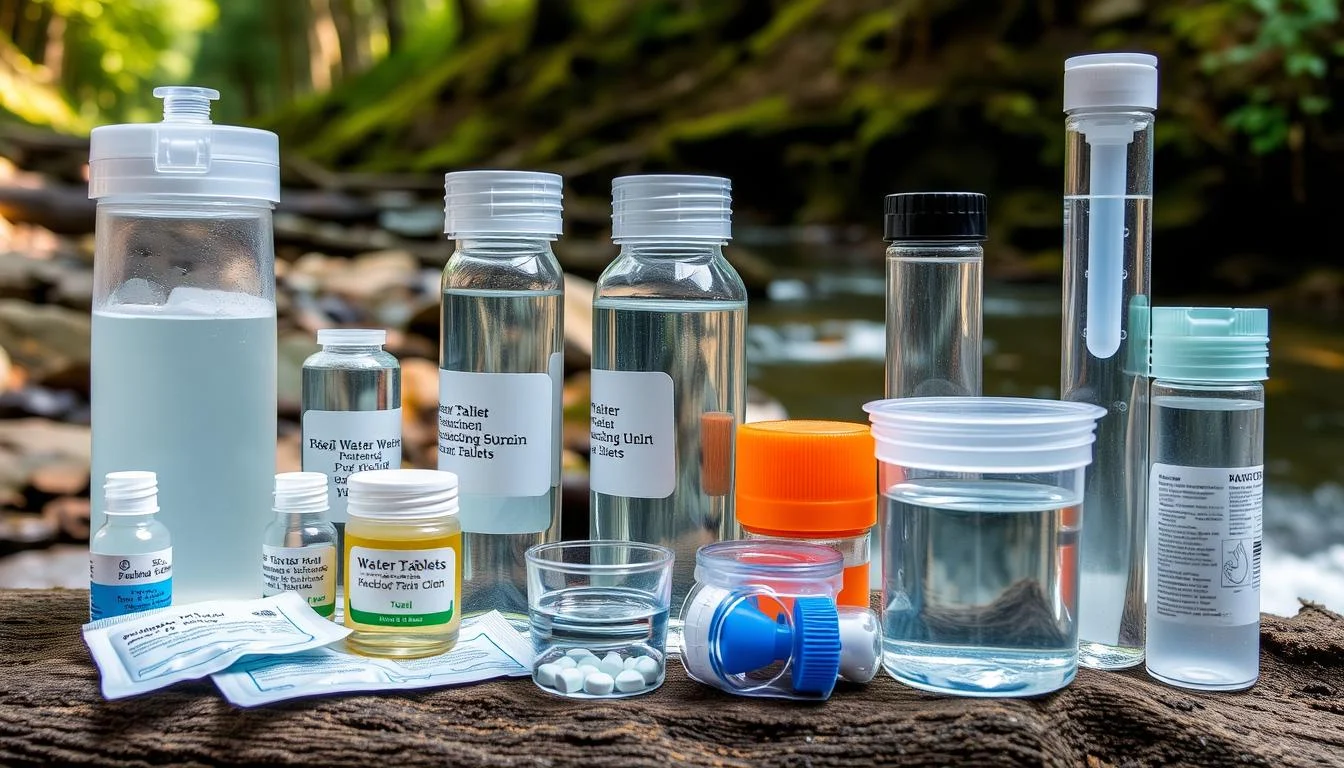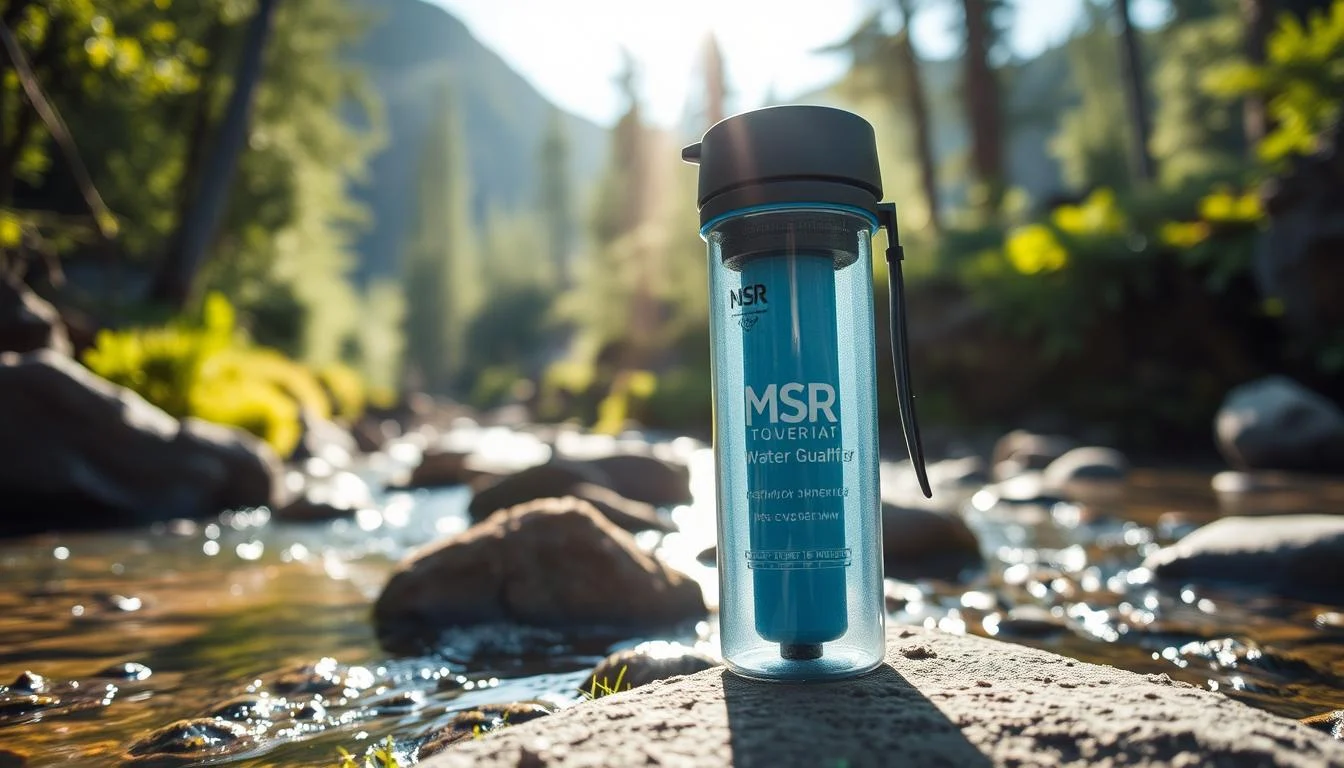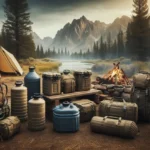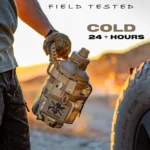
Water Purification for Camping – The Best Backpacking Water Filters of 2025
Ever wondered if that clear mountain stream is safe to drink? Planning your next outdoor adventure raises the question of water safety. In 2025, finding the best water purification for camping is more important than ever. Thanks to new tech, backpacking water filters now protect better against harmful stuff.
Those days of just using a water bottle are over. Today, campers face many water threats, from tiny bacteria to chemicals. So, picking the right water treatment system is key for staying healthy and calm in nature.

The water filter market has grown with many choices, each claiming to be the best for outdoors. You’ll find everything from super light personal filters to big gravity systems. But don’t worry – we’ve sorted it all out for you. Here’s a detailed guide to the top backpacking water filters of 2025.
💧 Cleaner Water, Healthier Life – Shop Top-Quality Water Purifiers Now!
Key Takeaways
- Proper water purification is vital for safe camping experiences
- Modern water filters offer protection against various contaminants
- Choosing the right filter depends on your specific camping needs
- New technologies have made water treatment more efficient
- Understanding different filtration methods helps in selecting the best option
Understanding Water Filtration Basics
When you’re out in the backcountry, finding clean water is key. Natural water sources can have harmful contaminants. Let’s look at the basics of water filtration and treatment to keep you safe on outdoor adventures.
Types of Contaminants in Natural Water Sources
Backcountry water often has harmful microorganisms and particles. These include:
- Bacteria (e.g., E. coli)
- Protozoa (e.g., Giardia)
- Viruses (in some regions)
- Sediment and debris
Different Water Treatment Methods
To get clean water, many filtration and purification methods work:
| Method | Effectiveness | Examples |
|---|---|---|
| Mechanical Filtration | Removes bacteria, protozoa, and particles | Sawyer Squeeze, Platypus GravityWorks |
| Chemical Treatment | Kills bacteria, viruses, and some protozoa | Aquamira Water Treatment Drops |
| UV Purification | Neutralizes microorganisms | SteriPEN |
Importance of Water Safety in the Backcountry
Having safe drinking water is essential for your health and fun outdoors. Bad water can make you sick and ruin your trip. By knowing about filtration and picking the right method, you’ll stay safe and hydrated on your adventures.
The right water filter depends on your group size, trip length, and water sources. For solo trips, consider the Sawyer Squeeze. For groups, the Platypus GravityWorks is better. Your choice will keep your water clean and safe for your outdoor fun.
🔥 Say Goodbye to Contaminants – Get Your Water Purifier Today!
Best Water Purification for Camping: Top Choices for 2025
Camping adventures need reliable water purification. The best backpacking water filters of 2025 offer many options. They range from ultralight to high-capacity systems, ensuring safe hydration in the wilderness.
The Sawyer Squeeze is great for solo travelers. It weighs just 2.5 ounces and has a lifetime warranty. It also has a 1.7 L/min flow rate. The LifeStraw Personal is another favorite, weighing only 1.6 ounces and filtering up to 4,000 liters.
Thru-hikers love the Katadyn BeFree 0.6L. It’s light and has a 2 L/min flow rate, perfect for long treks. For group camping, the Katadyn BeFree Gravity 3L is ideal. It’s a gravity filter system that processes water quickly, great for larger campsites.
| Filter Type | Top Choice | Weight | Price |
|---|---|---|---|
| Squeeze | Sawyer Squeeze | 2.5 oz | $39 |
| Gravity | Katadyn BeFree Gravity 3L | 6.8 oz | $75 |
| Pump | MSR MiniWorks EX | 1 lb | $120 |
Pump filter fans like the MSR MiniWorks EX. It’s heavier but durable and lasts up to 2,000 liters. The MSR Guardian water purifier is for ultimate protection. It removes viruses, bacteria, and protozoa, ideal for international travel.
Gravity Filters: The Ultimate Group Solution
When camping with a group, having a water filter that can handle lots of water is key. Gravity filters are perfect for this, making them the top choice for groups. Let’s explore the Platypus GravityWorks, a highly praised gravity filter system.
Platypus GravityWorks Overview
The Platypus GravityWorks is a favorite for group camping. It has a 6L capacity, great for serving many people. It’s also light, weighing only 11.5 ounces. The system filters up to 1,500 liters, lasting a long time on your adventures.

Flow Rate and Capacity
The Platypus GravityWorks has a fast flow rate. It filters water at 1.75 liters per minute. This means you don’t have to wait long for clean water. Its 6L capacity is also perfect for keeping a group hydrated.
Setup and Maintenance
Setting up the Platypus GravityWorks is easy. Just hang the dirty water bag, let gravity work, and collect clean water. To keep your filter in good shape:
- Backflush regularly to clear debris
- Store the filter damp to prevent drying and cracking
- Sanitize occasionally with a diluted bleach solution
With the right care, your Platypus GravityWorks will last for many camping trips. At $135, it’s a good investment for those who camp often and need a reliable water filter.
| Feature | Platypus GravityWorks | Sawyer Squeeze |
|---|---|---|
| Weight | 11.5 oz | 3.0 oz |
| Filter Life | 1,500 liters | Lifetime |
| Flow Rate | 1.75 L/min | 1.7 L/min |
| Price | $135 | $41 |
Lightweight Personal Filtration Systems
When you’re on the trails, every ounce matters. Lightweight personal filtration systems are perfect for solo travelers and ultralight enthusiasts. They let you filter water fast, keeping you hydrated without adding weight to your pack.
Sawyer Squeeze: A Backpacker’s Favorite
The Sawyer Squeeze is a top choice for many hikers. It weighs only 3 ounces, making it an ultralight water filter. It filters 1.7 liters of water per minute, saving you time at water sources.
It removes 100% of microplastics, harmful bacteria, and protozoa. This makes it a reliable option for backcountry adventures.

LifeStraw Peak Squeeze: Innovative Filtration
The LifeStraw Peak Squeeze introduces new tech to lightweight filtration. It’s known for its ease of use and effective contaminant removal. It’s designed for ultralight backpackers, balancing performance and portability.
Comparing Ultralight Options
For solo travelers, the choice often depends on weight and efficiency. Here’s a comparison of some popular ultralight filters:
| Filter | Weight | Flow Rate | Filter Life |
|---|---|---|---|
| Sawyer Squeeze | 3.0 oz | 1.7 L/min | Lifetime |
| Platypus QuickDraw | 2.9 oz | 3.0 L/min | 1,000 L |
| Katadyn BeFree | 2.3 oz | 2.0 L/min | 1,000 L |
Each filter has its own benefits. The Sawyer Squeeze lasts a long time, while the Platypus QuickDraw has a fast flow rate. Think about what’s most important to you – weight, speed, or lifespan – when picking your ultralight water filter for solo adventures.
🌟 Pure Water Starts Here – Explore the Best Water Purifiers Now!
Chemical Treatment Solutions

Chemical solutions are a quick and easy way to treat water. Water treatment drops and tablets are great for backpackers and campers. They are lightweight and compact. Let’s look at some top chemical water purification methods.
Aquamira water treatment stands out. It uses chlorine dioxide to purify water well. A 2 oz container costs about $15 and can treat up to 114 liters. It takes just 15 minutes to kill most germs, but wait 4 hours for full protection against cryptosporidium.
Potable Aqua and Micropur MP1 tablets are also good choices. Potable Aqua uses iodine and costs about $9. Micropur MP1 uses chlorine dioxide and costs $15. Both are easy to use but might leave a chemical taste in your water.
| Product | Active Ingredient | Price | Treatment Time |
|---|---|---|---|
| Aquamira Drops | Chlorine Dioxide | $15 | 15-240 minutes |
| Potable Aqua | Iodine | $9 | 35 minutes |
| Micropur MP1 | Chlorine Dioxide | $15 | 30-240 minutes |
Chemical treatments are cheaper than UV purifiers or advanced filters. They’re perfect for emergencies and lightweight backpacking. Always follow the instructions to make sure your water is safe to drink.
Advanced Purification Methods and Technologies
The MSR Guardian is a game-changer for top-tier water purification in camping. It offers unmatched protection for outdoor lovers and international travelers.
MSR Guardian System Analysis
The MSR Guardian purification system is impressive. It pumps 2.5 liters of water per minute, making it fast. It lasts up to 10,000 liters, perfect for many adventures.

Virus Protection Capabilities
The MSR Guardian filters out viruses, a key feature for safe water. It removes 99.99% of bacteria, protozoa, and viruses. This gives peace of mind for any adventure or travel.
Investment Value for International Travel
Though it costs more, the Guardian’s durability and protection are worth it. It’s great for frequent travelers or those in areas with bad water quality. Its ability to purify water from any source is priceless.
| Feature | MSR Guardian | Sawyer Squeeze |
|---|---|---|
| Flow Rate | 2.5L/min | 1.7L/min |
| Lifespan | 10,000L | 378,000L |
| Virus Protection | Yes | No |
The MSR Guardian’s strong purification makes it stand out from the Sawyer Squeeze. The Squeeze lasts longer but lacks the Guardian’s virus protection. So, the Guardian is the best for international travel and risky areas.
🚰 Drink with Confidence – Buy Reliable Water Purifiers Today!
Maintenance and Longevity Guide
Keeping your water filter or purifier in top shape is key to safe hydration on the trail. Let’s dive into some practical tips to extend your filter life and maintain your essential backpacking gear.
Cleaning and Storage Procedures
To clean the filter, backflush it with clean water after each use. This removes debris and prevents clogging. For storage, air dry your filter completely to prevent mold growth. Store it in a clean, dry place away from extreme temperatures.

Extending Filter Life
Pre-filter your water using a bandana or coffee filter to remove large particles. This simple step can significantly increase your filter’s lifespan. For example, the Sawyer Squeeze has an impressive lifetime volume of 378,000 liters when properly maintained.
Winter Protection Methods
Freezing can damage your water purifier. Keep it close to your body heat while hiking and sleeping. For overnight protection, place it in a sealed plastic bag and tuck it into your sleeping bag. Remember, a damaged filter can compromise your water safety, so always inspect it before use.
| Filter Model | Lifetime Volume | Weight | Price |
|---|---|---|---|
| Sawyer Squeeze | 378,000 L | 3 oz | $41 |
| Platypus GravityWorks | 1,500 L | 11.5 oz | $135 |
| LifeStraw Peak Squeeze | 2,000 L | 3.9 oz | $44 |
By following these guidelines, you’ll ensure your water filter remains a reliable companion on your backpacking adventures for years to come.
💥 Upgrade Your Hydration – Get Advanced Water Purifiers Today!
Price vs Performance Analysis
Choosing the best water filter for backpacking means finding a balance between cost and quality. We’ll compare popular options to help you pick the right one for your adventures.

The Sawyer Squeeze is a top pick for 2025. It costs $41 and filters up to 378,000 liters. It’s also very light, weighing only 3 ounces, making it great for long trips.
The Katadyn BeFree is ideal for those who want ultralight gear. It’s $45 and weighs just 2.3 ounces. It filters water fast, but it can only filter up to 1,000 liters.
The Platypus GravityWorks is best for groups. It costs $135 but can filter 4 liters at a time. It’s a bit pricey but has a good flow rate.
| Filter | Price | Weight | Lifetime Volume | Flow Rate |
|---|---|---|---|---|
| Sawyer Squeeze | $41 | 3 oz | 378,000 L | 1.7 L/min |
| Katadyn BeFree | $45 | 2.3 oz | 1,000 L | 2 L/min |
| Platypus GravityWorks | $135 | 11.5 oz | 1,500 L | 1.75 L/min |
| MSR Guardian | $390 | 17 oz | 10,000 L | N/A |
The MSR Guardian is the most protective option at $390. It’s the heaviest at 17 ounces but filters up to 10,000 liters. Your choice will depend on your needs, budget, and the water quality you expect.
🌿 Protect Your Family’s Health – Buy a Water Purifier Now!
Environmental Impact and Sustainability
Choosing the right water filters and purifiers for camping is key. It’s important to think about how they affect the environment. Many campers now look for eco-friendly options to reduce waste and help the planet.
Material Durability
The materials used in water filters are very important for the environment. High-quality filters, like the LifeStraw Peak Series Solo Water Filter, are made to last. This filter is very light, weighing only 1.7 oz, and can filter up to 2,000 liters of water before needing a new one.
By picking durable products, you help reduce waste. You won’t need to replace them as often.

Waste Reduction Features
Modern water filters are designed to remove contaminants while creating less waste. For example, the LifeStraw Peak Series is made from 50% post-consumer recycled BPA-free plastic. This choice helps lessen the environmental impact compared to using single-use plastic water bottles.
The filter can last up to 500 gallons. This long life also helps reduce waste.
Eco-friendly Options
Eco-conscious campers can find water purifiers that match their values. Some filters, like the LifeStraw, work with standard water bottles. This means you don’t need special equipment.
The LifeStraw is very effective, removing 99.999999% of bacteria and 99.999% of parasites. This ensures you have safe drinking water without using disposable plastic bottles.
By choosing sustainable water treatment options, you protect your health and help the environment. Every choice we make matters when we’re in nature. Let’s make sure to reduce our environmental footprint on camping trips.
Conclusion
Choosing the right backpacking water filters is key for clean drinking water on your trips. We’ve looked at many options, from small personal filters to big gravity systems.
The Sawyer Squeeze is great for removing bacteria with its .1 micron pore size. It’s also very light, weighing just 3 oz. For viruses, the MSR Guardian or Sawyer Point Zero are good choices. Chemical treatments and boiling are also safe ways to purify water in the wild.
What you choose depends on your needs. Solo travelers might like the Sawyer Squeeze for its lightness. Groups might prefer the Platypus GravityWorks or Katadyn Gravity BeFree. If you’re traveling internationally, a virus-removing filter like the MSR Guardian is a smart choice.
Remember to think about how long the filter lasts, how fast it filters water, and how it works in cold weather. This way, you can stay hydrated and healthy on your camping trips with the best water purification system!
💧 Purify Every Drop – Find the Best Water Purifiers Here!
FAQ
For “Water Purification for Camping – The Best Backpacking Water Filters of 2025”
Q: What is the difference between a water filter and purifier?
A: A water filter typically removes bacteria and protozoa from water, while a water purifier also eliminates viruses. Filters are generally sufficient for most backcountry water sources in North America, but purifiers are recommended for international travel or areas with higher contamination risks.
Q: What are the best backpacking water filters for 2025?
A: Some of the best backpacking water filters for 2025 include squeeze filters, straw filters, and bottle filters. Popular brands offer lightweight, compact options that can filter a liter of water quickly and efficiently, making them ideal for backpacking trips.
Q: How do I choose the right water purification system for backpacking?
A: When choosing a water purification system for backpacking, consider factors such as weight, filtration speed, ease of use, and the types of contaminants it removes. Also, think about the water sources you’ll encounter and the size of your group to determine the best water filter or purifier for your needs.
Q: Are chemical water treatments effective for purifying water while camping?
A: Yes, chemical water treatments can be effective for purifying water while camping. Options like iodine tablets or chlorine dioxide drops are lightweight and easy to use. However, they may alter the taste of the water and require a waiting period before consumption. They’re often used as a backup or in combination with a physical filter.
Q: How do I maintain my backpacking water filter?
A: To maintain your backpacking water filter, regularly backflush it according to the manufacturer’s instructions. Clean the filter elements after each trip, and store it properly when not in use. For squeeze filters, avoid letting them freeze, as this can damage the filter membrane. Replace filter cartridges as recommended to ensure optimal performance.
Q: What’s the best water filter for groups when backpacking?
A: For groups, consider a high-capacity water purification system that can filter large quantities of water with minimal effort. Gravity filters or large-capacity pump filters are often the best choice for groups, as they can process several liters of water quickly, making them efficient for camp use.
Q: Can I drink water directly from natural sources using a straw filter?
A: Yes, straw filters allow you to drink water directly from the source. However, they’re best suited for personal use and don’t allow you to filter water for storage. While convenient for quick drinks, they may not be ideal as your sole water purification method on longer backpacking trips where you need to carry water.
Q: How effective are UV water purifiers for backpacking?
A: UV water purifiers are effective at neutralizing bacteria, protozoa, and viruses in clear water. They’re lightweight and easy to use, making them popular among backpackers. However, they require batteries or charging, don’t work well with silty water, and don’t remove particulates or improve the taste of the water.
Q: What should I do if my water filter freezes during a backpacking trip?
A: If your water filter freezes, it may be damaged and unsafe to use. Many filters, especially those with hollow fiber membranes, can develop micro-cracks when frozen. If freezing occurs, switch to a backup purification method like chemical treatment or boiling. To prevent freezing, keep your filter close to your body or inside your sleeping bag on cold nights.
Q: How far should I be from water sources when camping?
A: When camping, set up your site at least 200 feet from any water source. This helps protect the water quality and minimizes your impact on the environment. It also reduces the risk of contaminating the water with human waste or camping-related pollutants. Always follow Leave No Trace principles when selecting your campsite and managing water.
Source Links
- Why the inline filter is revolutionizing outdoor hydration [2025]
- How your backpacking stove affects water purification choices
- Best water filters and purifiers for hiking in 2025: Our top picks for making wild water safe
- Smart water storage solutions every hiker needs to know
- Why one liter of water isn’t always enough for your adventure
- Just add water and wait: The simple guide to trail hydration
- The best filter choices that seasoned hikers swear by
- The Best Water Filters for Backcountry Hydration
- 5 ways to purify your water that experts recommend
- Staying safe with water in the backcountry: Essential tips
- When and how to treat your water on wilderness adventures
- Tutorial: Methods to purify backcountry water || Pros, cons & my picks
- Transform questionable water into safe drinking water instantly
- SimPure Hiking Water Filtration System
- The Best Backpacking Water Filters and Purifiers of 2024
- Why your water reservoir needs more attention than you think
- Getting water from shallow streams: A hiker’s survival guide
- Remove dangerous viruses from water with these proven methods
- Everything You Need to Know About Water Filtration for Thru-hiking, Hiking, Camping, and Bushcraft. — Becoming intermediate
- Best Gravity Water Filter for Backpacking [2025]
- Best Water Treatment System for the PCT — Hack Your Pack
Related Articles:
- The Best Water Storage Containers for Camping: Durable Drinking Water Solutions
- The Best Backpacking Water Filters of 2025: Top Picks & Reviews
- How do Hydration Packs Work? – Your Ultimate Guide to Stay Hydrated!
- Best Water Bottles for Hiking of 2025: Top Canteens & Stainless Steel Options
Our Partners: CSKDesignCrafts.com – FitFusioHub.com – DesignersReport.com
This post contains affiliate links, which means I may earn a commission if you make a purchase through these links. There is no additional charge to you! Thank you for supporting my blog so I can continue creating free content each week!




